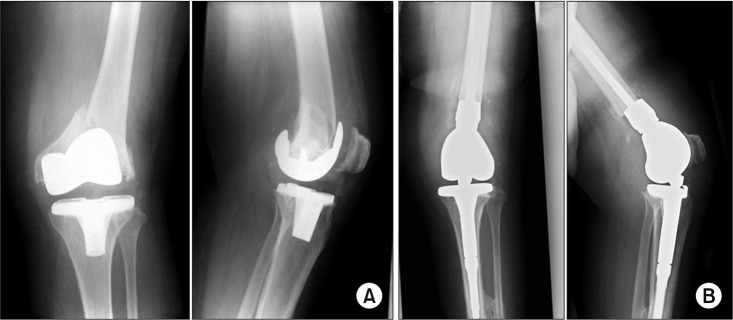Clin Orthop Surg.
2018 Jun;10(2):174-180. 10.4055/cios.2018.10.2.174.
Comparing Outcomes of Tumor Prosthesis Revision and Locking Plate Fixation in Supracondylar Femoral Periprosthetic Fractures
- Affiliations
-
- 1Department of Orthopaedic Surgery, Tan Tock Seng Hospital, Singapore, Singapore. gerrard.gan@mohh.com.sg
- KMID: 2411742
- DOI: http://doi.org/10.4055/cios.2018.10.2.174
Abstract
- BACKGROUND
Periprosthetic fractures around a total knee replacement (TKR) can be complex and difficult to manage, requiring the surgical expertise of the trauma and arthroplasty surgeon. There are a number of treatment modalities available, each with their own merits and limitations. As data on tumor prosthesis revision in periprosthetic fractures is sparse, this study aims to evaluate the results of revision using a tumor prosthesis and compare them with those of fixation using a locking plate in periprosthetic fractures after TKR.
METHODS
This is a retrospective study of 15 patients who underwent either tumor prosthesis revision (n = 7) or locking plate fixation (n = 8) for supracondylar femoral periprosthetic fractures in our hospital from 2009 and 2014. The mean follow-up time for these patients was 44 months. This study's main outcome measures were pain relief, return to premorbid ambulatory function, and complications.
RESULTS
The revision and fixation groups saw five versus three patients achieve pain relief (71.4% vs. 37.5%, p = 0.315), and two versus four patients return to their premorbid ambulatory function (28.6% vs. 50%, p = 0.608) at the follow-up, respectively. The mean time to weight-bearing in the revision group and fixation group was 2.9 days and 18.9 weeks, respectively (p = 0.001). There were eight complications seen in the revision group with none requiring reoperation; there were five complications seen in the fixation group, and two required reoperation.
CONCLUSIONS
The results of revision TKR using a tumor prosthesis were comparable to those of fixation using a locking plate in periprosthetic fractures after TKR. Tumor prosthesis revision may be considered as a viable alternative to locking plate fixation when indicated.
MeSH Terms
Figure
Reference
-
1. Rorabeck CH, Taylor JW. Periprosthetic fractures of the femur complicating total knee arthroplasty. Orthop Clin North Am. 1999; 30(2):265–277. PMID: 10196428.
Article2. Cordeiro EN, Costa RC, Carazzato JG, Silva Jdos S. Periprosthetic fractures in patients with total knee arthroplasties. Clin Orthop Relat Res. 1990; (252):182–189. PMID: 2302883.
Article3. Dennis DA. Periprosthetic fractures following total knee arthroplasty. J Bone Joint Surg Am. 2001; 83(1):119–130.
Article4. Culp RW, Schmidt RG, Hanks G, Mak A, Esterhai JL Jr, Heppenstall RB. Supracondylar fracture of the femur following prosthetic knee arthroplasty. Clin Orthop Relat Res. 1987; (222):212–222.
Article5. Chen F, Mont MA, Bachner RS. Management of ipsilateral supracondylar femur fractures following total knee arthroplasty. J Arthroplasty. 1994; 9(5):521–526. PMID: 7807110.
Article6. Healy WL, Siliski JM, Incavo SJ. Operative treatment of distal femoral fractures proximal to total knee replacements. J Bone Joint Surg Am. 1993; 75(1):27–34. PMID: 8419387.
Article7. Ritter MA, Keating EM, Faris PM, Meding JB. Rush rod fixation of supracondylar fractures above total knee arthroplasties. J Arthroplasty. 1995; 10(2):213–216. PMID: 7798104.
Article8. Johnston AT, Tsiridis E, Eyres KS, Toms AD. Periprosthetic fractures in the distal femur following total knee replacement: a review and guide to management. Knee. 2012; 19(3):156–162. PMID: 21741844.
Article9. Jassim SS, McNamara I, Hopgood P. Distal femoral replacement in periprosthetic fracture around total knee arthroplasty. Injury. 2014; 45(3):550–553. PMID: 24268192.
Article10. Mortazavi SM, Kurd MF, Bender B, Post Z, Parvizi J, Purtill JJ. Distal femoral arthroplasty for the treatment of periprosthetic fractures after total knee arthroplasty. J Arthroplasty. 2010; 25(5):775–780. PMID: 20171053.
Article11. Rorabeck CH, Taylor JW. Classification of periprosthetic fractures complicating total knee arthroplasty. Orthop Clin North Am. 1999; 30(2):209–214. PMID: 10196422.
Article12. Berend KR, Lombardi AV Jr. Distal femoral replacement in nontumor cases with severe bone loss and instability. Clin Orthop Relat Res. 2009; 467(2):485–492. PMID: 18523831.
Article13. Springer BD, Sim FH, Hanssen AD, Lewallen DG. The modular segmental kinematic rotating hinge for nonneoplastic limb salvage. Clin Orthop Relat Res. 2004; (421):181–187.
Article14. Pour AE, Parvizi J, Slenker N, Purtill JJ, Sharkey PF. Rotating hinged total knee replacement: use with caution. J Bone Joint Surg Am. 2007; 89(8):1735–1741. PMID: 17671012.15. Cannon SR. The use of megaprosthesis in the treatment of periprosthetic knee fractures. Int Orthop. 2015; 39(10):1945–1950. PMID: 26311510.
Article16. Saidi K, Ben-Lulu O, Tsuji M, Safir O, Gross AE, Backstein D. Supracondylar periprosthetic fractures of the knee in the elderly patients: a comparison of treatment using allograft-implant composites, standard revision components, distal femoral replacement prosthesis. J Arthroplasty. 2014; 29(1):110–114. PMID: 23680503.
Article17. Dindo D, Demartines N, Clavien PA. Classification of surgical complications: a new proposal with evaluation in a cohort of 6336 patients and results of a survey. Ann Surg. 2004; 240(2):205–213. PMID: 15273542.
- Full Text Links
- Actions
-
Cited
- CITED
-
- Close
- Share
- Similar articles
-
- Treatment of Periprosthetic Supracondylar Femur Fractures following Total Knee Arthroplasty: Minimally Invasive Technique using Locking Condylar Plate
- Periprosthetic Fractures Following Total Knee Arthroplasty
- Treatment of Femur Supracondylar Fracture with Locking Compression Plate
- The Problems of Plate Fixation in the Management of Periprosthetic Femoral Fracture
- Treatment for Periprosthetic Supracondylar Femur Fractures Following Total Knee Arthroplasty -Comparative Study of Retrograde Intramedullary Nailing and Locking Compression Plate Fixation-



